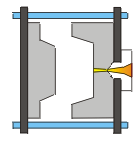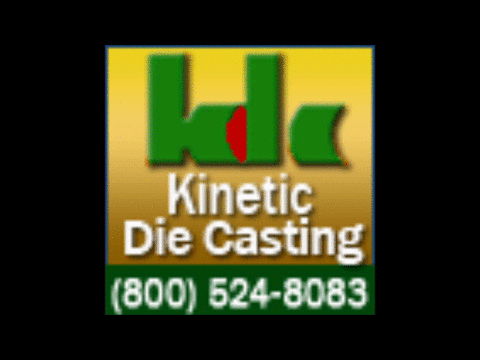Die Casting Porosity and Its Causes. Die Casting porosity is one of the most common defects in the die casting manufacturing industry. What is die casting porosity? Die Casting porosity is a kind of die casting factory imperfection in which …
Continue reading
Category Archives: Die Casting Alloys
50 Percent Duty on Aluminum Imports

818-982-9200
www.kineticdc.com
As the White House prepares to submit the Trans-Pacific Partnership to Congress in the coming months, it has been touting its record on trade enforcement to persuade lawmakers to vote for the 12-nation pact. The United Steelworkers union on Monday upped the ante on that front by asking President Barack Obama to impose a 50 percent duty on aluminum imports from China and other suppliers as soon as July.
The U.S. International Trade Commission would normally take up to six months to investigate the Section 201 petition for global import relief and make recommendations to Obama, who would have another two months to decide what action to take. However, the union is asking the ITC to make a finding of “critical circumstances” within 60 days so Obama can act quickly to keep additional U.S. aluminum smelters from closing.
If the trade panel makes that determination, the president would then have 30 days to approve some of type of provisional relief while the Section 201 case proceeds for another six to eight months, Terry Stewart, a lawyer for the union group, said.
The timing isn’t ideal for Obama’s TPP push. The aluminum case potentially puts the president on the spot by forcing him to decide whether to impose the 50-percent “provisional” duty sought by the steelworkers while the Section 201 investigation proceeds. If he decides against it or puts in place some lesser relief, that could jeopardize potential votes for the TPP pact.

Different Types of Aluminum Castings
 Different Types of Aluminum Castings. Aluminum die castings are used to by a lot of metalworking companies to form the perfect aluminum material, without having to spend a lot of money and wasting a lot of time. Due to the versatility of these processes, a lot of companies have turned to this unique way in forming one of the most dependable alloys that is used for several components in the same industry. There are a lot of items that were produced out of aluminum castings from the Washington Monument’s cap to the ancient tea kettles used by people who lived hundreds and hundreds of years ago. Although there have been a lot of improvements in the process of aluminum castings, most of the companies still resort to the traditional means of using molten metal to form some of the most intricate dies in history.
Different Types of Aluminum Castings. Aluminum die castings are used to by a lot of metalworking companies to form the perfect aluminum material, without having to spend a lot of money and wasting a lot of time. Due to the versatility of these processes, a lot of companies have turned to this unique way in forming one of the most dependable alloys that is used for several components in the same industry. There are a lot of items that were produced out of aluminum castings from the Washington Monument’s cap to the ancient tea kettles used by people who lived hundreds and hundreds of years ago. Although there have been a lot of improvements in the process of aluminum castings, most of the companies still resort to the traditional means of using molten metal to form some of the most intricate dies in history.
Furthermore, Aluminum castings can come in three diverse methods. Out of the three (permanent mold casting, sand casting and die casting), die casting is considered as the most popular among all companies in the metalworking industry. Although sand casting is known to be more versatile due to its delicate patterns, die castings prove to produce the most durable components used by a lot of automobile franchises and even the smallest of modern electronic gadgets. Other would say, however, that permanent mold castings also produce durable materials, but may need more expensive equipments and methodologies compared to the two other methods. Although these three processes may have a lot of differences, it can be agreed that aluminum die castings are highly effective in whichever method they are performed under.
Kinetic Die Casting Company makes Aluminum Casting Parts. As a die casting company, we make these parts every day and ship thousands of these aluminum die castings every week.
Contact us to get die casting prices http://www.kineticdiecasting.com/replyform.html.
Kinetic Die Casting Company
6918 Beck Avenue
North Hollywood, California 91605
Sales@kineticdc.com
The Alloys of Die Casting
 The Alloys of Die Casting. Aluminum is one of the most common alloys used in die casting. Aluminum is also one of the many alloys that can undergo almost all the process in casting. Die casting is where the aluminum is mostly used. But pure aluminum casting is rarely produced because of the susceptibility of the alloy to cracking and shrinkage. This alloy is usually alloyed with silicon and copper because these two alloys can increase melt fluidity, especially silicon, and reduces ductility. Silicon can also reduce maintainability of the alloy and copper can increase the hardness. The combination of the three alloys can reduce corrosion. For better corrosion resistance, aluminum casting with lower copper should be used such as 360 and 413. Aluminum is also commonly used when it comes to electricity because of its conductivity and high temperature strength. Aluminum has many uses in today’s everyday lives from office to home to commercial uses and industrial uses.
The Alloys of Die Casting. Aluminum is one of the most common alloys used in die casting. Aluminum is also one of the many alloys that can undergo almost all the process in casting. Die casting is where the aluminum is mostly used. But pure aluminum casting is rarely produced because of the susceptibility of the alloy to cracking and shrinkage. This alloy is usually alloyed with silicon and copper because these two alloys can increase melt fluidity, especially silicon, and reduces ductility. Silicon can also reduce maintainability of the alloy and copper can increase the hardness. The combination of the three alloys can reduce corrosion. For better corrosion resistance, aluminum casting with lower copper should be used such as 360 and 413. Aluminum is also commonly used when it comes to electricity because of its conductivity and high temperature strength. Aluminum has many uses in today’s everyday lives from office to home to commercial uses and industrial uses.
Furthermore, Aluminum Die Casting also has high dimensional stability when doing complex shapes and thin walls. The typical applications of aluminum alloy are Alloy 380.0, A380.0, 360, 413, and 518.1. They are typically used for home equipment like lawnmower, dental equipment, street lamp housings, frying skillets, escalator parts, connecting rods, instrument cases, and marine and aircraft hardware. Alloy 518 is known to have the highest corrosion resistance but it has low fluidity compared to the other aluminum alloys. This is also usually the most expensive aluminum alloy because of the difficulty to cast.
Also, Aluminum casting usually doesn’t undergo heat treatment but instead undergo metallurgical stabilization and dimensional treatment.
Why are Aluminum Die Casting Parts better than Zinc Diecast Parts
Thank you for reading our newsletter. Please feel free to make a comment below about this article. You can also visit our facebook page to see other topics we are sharing with our customers. If you have suggestions for future articles, please send them to us.
Here is a comparison of aluminum parts and zinc parts:
Die Casting Tooling
A die casting mold made for an aluminum part runs in a cold chamber die casting machine. The die casting alloys aluminum and zinc both run in a cold chamber die casting machine. So if the die casting mold is made for aluminum, it will produce parts in zinc or aluminum. A zinc hot chamber die will not make parts in aluminum.
Die Casting Part Weight
Although an aluminum die casting mold will make parts in zinc or aluminum, the cost of the zinc parts will be higher. By volume, zinc materials weigh about twice as much as aluminum alloys. The costs per pound of the two die casting alloys are almost equal, so the cost for zinc parts is significantly higher than the cost for aluminum parts.
Electrical Conductivity
Aluminum is the third most electrically conductive metal after gold and copper. Therefore, aluminum is the better choice for EMI/RF shielding and for electrical grounding. Zinc rates far below aluminum in electrical conductivity.
Thermal Conductivity
Most electrical heat sinks are produced in aluminum alloy because it is superior to zinc alloy in thermal conductivity.
Recyclability
Aluminum is the most recycled metal in the world. All aluminum die casting alloys are made from recycled aluminum products.
Thank you for reading our newsletter:
Kinetic Die Casting Company (www.kineticdc.com)
6918 Beck Avenue North Hollywood CA 91605
(sales@kineticdc.com) 818-982-9200
To get a competitive price on an aluminum die casting part, click on this link: http://www.kineticdiecasting.com/replyform.html
Why are Aluminum Die Casting Parts better than Zinc Diecast Parts
Aluminum Manufacturing
 Aluminum Manufacturing. Aluminum is widely used in die casting because of the properties that it possesses. Aluminum is useful even in everyday life because that is why die casting companies produce die cast parts made from this alloy. Aluminum alloy is lightweight and has good corrosion resistance. It can also take high temperatures so the things that need to be heat resistant are usually made of aluminum alloy. The things that also need high corrosion resistance and electrical conductivity are made of aluminum. Due to its high dimensional stability, aluminum alloy is used to make thin walls and complex shapes.
Aluminum Manufacturing. Aluminum is widely used in die casting because of the properties that it possesses. Aluminum is useful even in everyday life because that is why die casting companies produce die cast parts made from this alloy. Aluminum alloy is lightweight and has good corrosion resistance. It can also take high temperatures so the things that need to be heat resistant are usually made of aluminum alloy. The things that also need high corrosion resistance and electrical conductivity are made of aluminum. Due to its high dimensional stability, aluminum alloy is used to make thin walls and complex shapes.
Furthermore, Aluminum die casting part types can depend on the combination of alloying elements such as silicon and copper. Zinc can also be used as alloying element to aluminum. The combination of the properties of the different alloys allows the production of high quality products. Silicon increases melt fluidity that is why complex parts such as connector housings and thin walls are made of aluminum with silicon. When copper is used as the alloying element, the part has increased hardness and decreased ductility.
Aluminum part types can be differentiated on the amount of alloying element present. Aluminum types are Alloy A380, A360, A369, A390, A413, and A518. They are series of aluminum alloys so expect to see alloy types with decimals. The Alloy A380 is the most common aluminum alloy used in die casting. Lawnmower housings and gears are usually made of AA 380. Escalator parts and conveyor parts are usually made of Alloy 518. Parts that need high corrosion resistance are made of Alloy A360 aluminum parts.
Parts differ in the content of alloying element that makes the aluminum part types. They also cater to the different needs of the consumers and the producers as well. These are the most common Aluminum Alloy Types.
Kinetic Die Casting Company makes Aluminum Casting Parts. As a die casting company, we make these parts every day and ship thousands of these aluminum die castings every week.
Contact us to get die casting prices http://www.kineticdiecasting.com/replyform.html.
Kinetic Die Casting Company
6918 Beck Avenue
North Hollywood, California 91605
Sales@kineticdc.com

